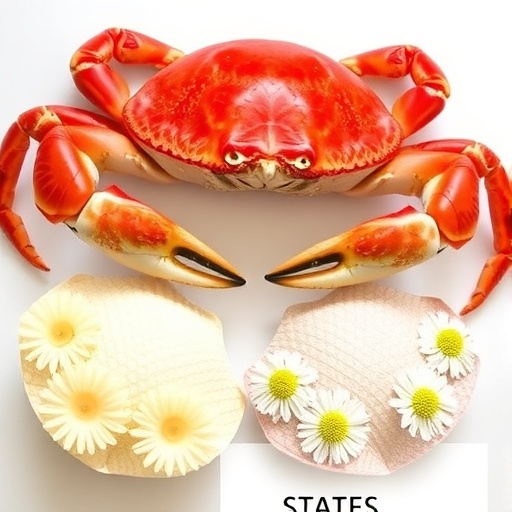In a groundbreaking study that melds sustainability with innovation, researchers have turned their attention to the valorization of red crab shell waste, which has often been dismissed as mere refuse. This forward-thinking research, led by scientists Silva, Godoi, and da Rocha, explores the potential of converting this abundant marine waste into chitosan films. The resulting materials not only promise a more sustainable approach to waste management but also exhibit remarkable properties for the adsorption of the dye Reactive Black 5, a common pollutant in textile effluents.
The concept of valorization revolves around the idea of deriving value from waste. With seafood industries generating significant amounts of shell waste, particularly from crustaceans like red crabs, there is an urgent need for effective strategies to mitigate environmental pollution. This research addresses that need, taking a proactive stance towards the development of eco-friendly solutions. By transforming crab shells, typically discarded, into valuable products, the study represents a significant stride towards a circular economy in the marine food industry.
Chitosan, a biopolymer derived from chitin found in crustacean shells, has gained traction across various sectors, including pharmaceuticals, agriculture, and environmental science. Its biocompatibility, biodegradability, and non-toxicity position it as an ideal candidate for creating sustainable alternatives in multiple applications. The current study capitalizes on these properties, focusing on producing chitosan films from red crab shell waste, thus highlighting the potential of this material in pollution management.
One of the central objectives of this research is to enhance the adsorption capacity of chitosan films for Reactive Black 5, which is notorious for its persistence in water and potential health hazards. The dye is frequently used in the textile industry and can lead to severe environmental degradation if not properly managed. By optimizing the chitosan films created from crab shells, the researchers aim to provide an effective and natural means of treating wastewater contaminated with such synthetic dyes.
The process of creating chitosan films begins with the extraction of chitin from the crab shells, which is then deacetylated to form chitosan. This procedure is not only straightforward but also environmentally friendly, reducing the carbon footprint associated with the production of synthetic materials. The final chitosan films exhibit unique characteristics, including a high surface area and functional groups that facilitate the adsorption process of dyes.
Preliminary results from the research indicate that these chitosan films possess an impressive ability to adsorb Reactive Black 5 from aqueous solutions. Various experiments reveal that factors such as pH, contact time, and initial dye concentration significantly influence the adsorption efficiency. This extensive evaluation demonstrates the versatility and effectiveness of chitosan films in real-world applications, particularly in wastewater treatment systems.
The implications of this research extend beyond just the textile industry. By providing a viable solution for dye removal, the study aligns with global sustainability goals aimed at reducing industrial waste and enhancing water quality. The valorization of crab shell waste into functional materials serves as an exemplary model of how waste can be transformed into resources, contributing to more sustainable industrial practices.
Moreover, the study opens up avenues for further research. Investigating the potential of other marine waste products to create similar or alternative materials could pave the way for wider applications in environmental remediation. It may also trigger innovations in how industries perceive and manage waste, ultimately leading to a more responsible and circular economic model.
Another critical aspect of this research is its contribution to the growing literature on biopolymer applications in environmental engineering. As the drive for sustainable materials intensifies, findings such as those presented by Silva and colleagues shed light on the untapped potential of natural materials in addressing complex environmental challenges. The positive experimental outcomes pave the way for industries to consider alternative biobased materials as feasible options for pollution control.
In conclusion, the work by Silva, Godoi, and da Rocha represents a significant advancement in the field of environmental science. Harnessing the potential of red crab shell waste not only presents a new methodology for wastewater treatment but also promotes a sustainable cycle of production and consumption. As we face increasing environmental challenges, studies such as this illuminate a path forward, where innovation and sustainability coalesce to create meaningful solutions.
The valorization of red crab shell waste into chitosan films for enhanced Reactive Black 5 adsorption offers an invaluable contribution to environmental sustainability. By embracing marine byproducts and transforming them into functional materials, this research encapsulates the spirit of innovation driving the modern quest for sustainable solutions. Future efforts should build on this work, ensuring that the lessons learned are applied to a broader spectrum of environmental challenges, ultimately driving us toward a cleaner and more sustainable planet.
In summary, the groundbreaking research conducted by Silva and colleagues showcases the potential embedded in marine waste. By creating chitosan films from red crab shells, the team not only finds a solution to manage dye pollution effectively but also contributes to a broader understanding of how waste materials can be reimagined as valuable resources. This study is an important step forward in the quest for sustainable environmental practices, embodying the fusion of science, innovation, and responsibility that is imperative for our future.
Subject of Research: Valorization of red crab shell waste into chitosan films for enhanced dye adsorption.
Article Title: Valorization of red crab shell waste into chitosan films for enhanced Reactive Black 5 adsorption.
Article References: Silva, C.H.L., Godoi, M. & da Rocha, M. Valorization of red crab shell waste into chitosan films for enhanced Reactive Black 5 adsorption. Environ Sci Pollut Res (2025). https://doi.org/10.1007/s11356-025-36940-0
Image Credits: AI Generated
DOI:
Keywords: Sustainable materials, chitosan films, wastewater treatment, environmental science, marine waste valorization.




